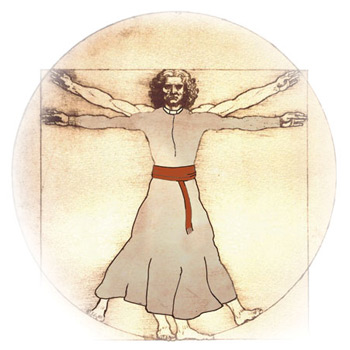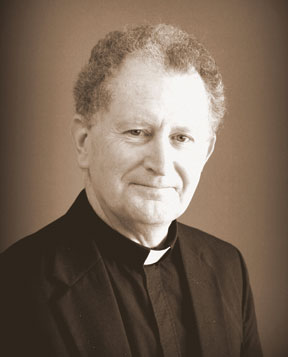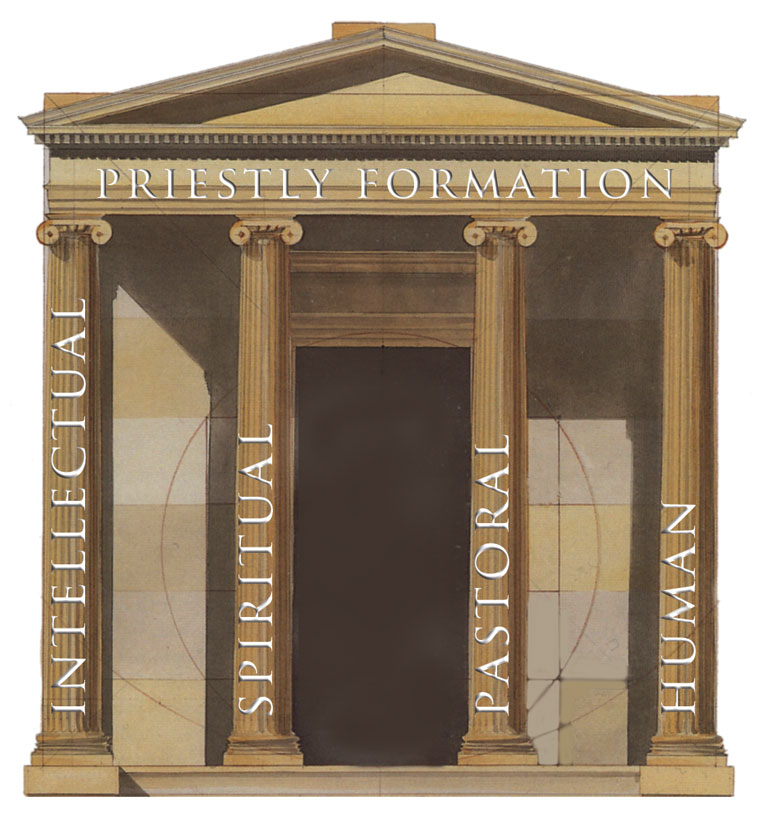Catholic priests and seminarians face unprecedented challenges: Emerging theologies and technologies. Rapid changes in family and social life. Educated lay women and men in church leadership. Fewer priests and religious overseeing more people in the pews than ever before. And hovering over all, the fallout from sex abuse travesties of the last decades.
Even this abbreviated enumeration of Catholic issues can sound like chaos. But to Msgr. Jeremiah McCarthy, executive director of the Seminary Department of the National Catholic Educational Association (NCEA), problems must be met head on. From his vantage, the church’s challenges are significant. But at the same time, he fosters collaborative and creative approaches to problem solving in seminary education. And he welcomes new understandings that arise through dialogue with wise leaders of other faith traditions.
 When McCarthy was named executive director of the NCEA’s Seminary Department, he was serving as professor of moral theology at St. Patrick’s Seminary and University in Menlo Park, California. But prior to that he was director of accreditation and institutional evaluation for the Association of Theological Schools in the United States and Canada (ATS). He had previously served St. John’s Seminary in Camarillo, California, as professor of moral theology, academic dean, and finally rector from 1994 to 2001.
When McCarthy was named executive director of the NCEA’s Seminary Department, he was serving as professor of moral theology at St. Patrick’s Seminary and University in Menlo Park, California. But prior to that he was director of accreditation and institutional evaluation for the Association of Theological Schools in the United States and Canada (ATS). He had previously served St. John’s Seminary in Camarillo, California, as professor of moral theology, academic dean, and finally rector from 1994 to 2001.
At the NCEA Seminary Department, McCarthy edits the association’s Seminary Journal and is managing a grant-funded initiative on international priests. He regularly helps seminaries meet challenges related to accreditation, institutional advancement, and other fields. He earned a Ph.D. in moral theology from the Graduate Theological Union in Berkeley and a licentiate in sacred theology from the Jesuit School of Theology at Berkeley. He is a priest of the Diocese of Tucson, Arizona, and a member of the board of directors of In Trust.
We recently sat down with McCarthy to ask him how Catholic seminaries are training priests for a changing church and world.
How are Catholic seminaries preparing future priests to work collaboratively with lay women and men?
In several ways, but mostly through curriculum. Almost all seminaries have courses or seminars in the fourth year that look at parish administration and the roles of the pastor. They also have leadership training courses. And there are field education placements where seminarians are supervised by lay leaders. Mount St. Mary’s Seminary in Emmitsburg, Maryland, even has a Lilly Endowment grant for leadership training and development that can be a model for other schools.
The traditional apprenticeship model is long gone—the time when a young priest would serve 15 or 20 years as an assistant pastor or parochial vicar before becoming pastor of a parish. Because of the priest shortage, young priests are already pastors in five or even fewer years following ordination. Collaboration with lay women and men is a given.
How are seminaries meeting the challenges faced by seminarians from outside the English-speaking world—those who have a limited knowledge of English and North American culture?
In 2011–12, 24 percent of students in U.S. Catholic seminaries were from other countries. Most of these are preparing to work in American dioceses, but about 10 percent will go back to their home countries. 
The seminaries are working on a variety of strategies to help these internationals — not only within the formal elements of the curriculum, but also in the tone or climate of the seminary. In other words, they are creating an “implicit” curriculum that creates an atmosphere in which we see international students as gifts to us and not as a challenge.
The Seminary Department has an excellent program called Parresia (the New Testament Greek word for “boldness”) that is designed to provide a variety of web-based resources to help both international seminarians and priests, on the one hand, and receiving dioceses and parishes, on the other. These resources can help a parish learn about their new priest’s home culture, but they can also teach the new priest about the culture of the parish he’ll be serving.
Cultural adaptation and language skills are big issues for international students and priests — even sensitivity to food is important. When I was rector at St. John’s Seminary in Camarillo, we appointed a director of language and cultural studies. Other seminaries are doing similar things like coaching in speaking American-accented English.
According to the normative document that guides priestly formation in the United States, the Program of Priestly Formation (PPF), there are four major objectives for formation (intellectual, pastoral, spiritual, and human) that are to be achieved in an integrated and holistic manner. Seminaries are sensitive to the cultural implications of these objectives. For example, in order to attend more sensitively to the spiritual formation needs of Vietnamese students, seminaries usually make sure that there are qualified Vietnamese spiritual directors for these students.
Another adjustment for foreign students is the American tradition of Socratic dialogue in the classroom—give-and-take interactions between students and faculty are often uncommon in other countries. In my experience, faculty members work hard to ensure their pedagogical strategies enable international students to succeed.
Are seminaries sponsored by religious congregations and orders different from those sponsored by dioceses?
The programs in both types of seminaries have much in common. The PPF lays out four key dimensions or “pillars” that form the basis of a seminarian’s program of study and preparation for ordination:
■ Intellectual formation. This is the M.Div. curriculum.
■ Spiritual formation. This ensures that the seminarian addresses spiritual growth through prayer and spiritual direction.
■ Pastoral formation. This refers to pastoral training, including field education and internship experiences.
■ Human formation. The PPF uses the term “affective maturity” to describe these capacities, but you could also use the phrase “emotional intelligence.”
 In addition, the seminaries sponsored by religious congregations such as Benedictines or Jesuits also include programs that develop understandings and lived experiences of the congregation’s particular spirituality or charism. [A “charism” is the particular mission of a religious order, usually articulated by its founder.]
In addition, the seminaries sponsored by religious congregations such as Benedictines or Jesuits also include programs that develop understandings and lived experiences of the congregation’s particular spirituality or charism. [A “charism” is the particular mission of a religious order, usually articulated by its founder.]
Among North American Catholics there is a divide between those who are “progressive” and those who are “traditional” or “conservative.” How are seminaries helping future priests understand this spectrum?
Here I need to cite the work of the wonderful researcher, the late Dr. Dean R. Hoge, and his colleagues at Catholic University’s Institute for Policy Research and Catholic Studies.
Hoge developed two useful models to describe differences among cohorts or age groups of priests.
The first model, the image of the priest as a “servant-leader,” reflects the preferred style of an older generation of priests whose life experience has spanned the pre- and post-Vatican II church. Having grown up in a strong, stable Catholic culture with a secure sense of priestly identity, these older priests understand their style of ministry as collaborative and collegial. They tend to be comfortable with leadership shared with lay women, lay men, and members of religious communities.
The second model, the image of the priest as a “cultic leader,” reflects the experience of a younger generation of priests whose preferred style gravitates toward the liturgical roles of priestly leadership. Many of these fine priests, members of the millennial generation, have grown up in an American Catholic world that is much more diverse and pluralistic. They have had to fight for a strong Catholic identity as well as a priestly identity.
I can recommend recent research on priests conducted by the Center for Applied Research in the Apostolate (CARA). Some of this research was recently published in Same Call, Different Men: The Evolution of the Priesthood Since Vatican II (Liturgical Press, 2012). The challenge is to acknowledge these different patterns and understandings of priestly identity, finding constructive ways for priests to work together rather than allowing the differences to be a source of division.
One of the great contributions that seminary rectors and faculty are making to bridge potential conflicts in the priesthood is the increased emphasis on solid human formation, emphasizing emotional intelligence as well as intellectual capacity. Seminarians need to distinguish between orthodoxy and rigidity. A mature priest must forego rigidity in pastoral settings.
It seems there is a huge challenge for seminary faculty in this area.
Yes, they have to model respectful listening and encourage dialogue in the classroom. In addition, seminary-based spiritual direction and human formation programs help students develop respect and a welcoming attitude toward all the baptized faithful. The late Msgr. Phil Murnion, founder of the National Pastoral Life Center, often said, “Priesthood is not a license for private practice.” At the seminary the student must learn how a pastor works with the whole flock.
Priestly identity is not a zero-sum game — the servant- leader and cultic models are not exclusive. The seminary must help students develop a vision that is appreciative of all and that fosters collaboration. We recognize that faculty development is critical, and we constantly ask, “Where are priest formators going to come from in the future?”
Among the many challenges seminaries face is the recruitment of talented, qualified priests to serve on seminary staffs alongside excellent lay people and dedicated religious community members.
How do Catholic and non-Catholic seminaries engage in dialogue and collaboration?
One of the fruits of Vatican II is ecumenical outreach. We see this structurally in consortia and collaborations like the Boston Theological Institute, the Association of Chicago Theological Schools, and the Graduate Theological Union in Berkeley. But there is still great need to strengthen ecumenism in interreligious dialogue.
It is happening in the seminaries. Sister Katarina Schuth, one of the foremost researchers on Catholic theological education, has data on the curricular offerings that promote ecumenism. Some seminaries, for example, have built courses into their curriculum that examine the differing theological traditions. Sister Mary C. Boys and Dr. Scott Alexander have published a wonderful article titled “Christian Hospitality and Pastoral Practices from a Roman Catholic Perspective” (Theological Education 47:1, 2012, pages 47–73) that details the need for respectful lived experiences that go beyond intellectual engagement to strengthen dialogue in a multifaith society. These experiences highlight the values of hospitality and receptivity, which enable us to appreciate the “other” as a gift and source of blessing.
There is always the argument that the crowded demands of the curriculum challenge ecumenical efforts, but more and more our seminaries are intentional about addressing this.
What do you see as the greatest challenges to future Catholic leadership, and how do you foresee that seminaries will meet them?
Recently Daniel O. Aleshire, executive director of ATS, shared reflections at a gathering of Catholic seminary leaders. The increasing percentage of lay members on seminary faculties requires the schools to be attentive to their distinctive formation needs, he said. In addition, the growing numbers of lay students requires careful attention to their personal and spiritual formation. The shortage of priests will not be reversed easily, and the training of lay professionals with the same kind of comprehensive, integrated learning required by the PPF will be an ongoing challenge.
Also, maintaining strong and stable enrollments and avoiding competition for students are daunting challenges and require ongoing conversations to ensure the support of bishops and vocation directors. According to ATS data, Catholic seminaries have the highest percentage of visa [i.e., international] students among ATS schools. So, educating priestly leadership for the most multicultural church in the North America is crucial.
Recruiting the next generation of priest formators and developing a national approach to sustaining the future of seminaries is essential. The flourishing of lay ministry is a great blessing, and ensuring that future priests have the confidence and collaborative leadership skills to be effective pastors, with special emphasis on intercultural competencies, will require strong leadership by seminary boards.
As a former seminary rector, I can testify that a strong board is critical for the well-being of the seminary, especially since administrative leadership at the level of the rector is dramatically changing. In the past two years, there are 22 new rectors at the helm of college-level and graduate- level seminaries in the United States. Assisting this new generation of leaders includes helping them to know how to work effectively with a board of directors.
And finally, in light of the election of Pope Francis, do you see that seminary education will be affected?
I don’t anticipate any changes to seminary training. The Second Vatican Council called for updating seminary formation in the Decree on Priestly Formation and established a basic template for renewal of formation programs in a document called the Ratio Fundamentalis, the “basic guidelines” for seminary training. The national conferences of bishops around the world adapted these guidelines to meet local circumstances. The PPF that I described earlier was the U.S. bishops’ response to that, and it has been updated at regular five- to seven-year intervals since 1971.
A sixth edition of the PPF is currently under review by seminary administrators, and we expect it to be approved by the U.S. Conference of Catholic Bishops in September 2015. This updating is well established and has proved effective. So I don’t foresee any dramatic changes in light of papal change. There could be some changes that would emerge as a result of the recent shift of seminary and priestly formation oversight in Rome from the Congregation for Catholic Education to the Congregation for Clergy. But at this point, it is too early to tell if changes may be in the works.
The National Catholic Educational Association
The National Catholic Educational Association NCEA is the largest private professional education organization in the world, providing service and direction in evangelization, leadership, catechesis, and teaching the mission of the Catholic Church. The NCEA’s Seminary Department comprises 60 seminaries, which educate future diocesan priests at the college and graduate levels, as well as houses of formation, schools of theology, and other institutions that prepare men and women both for lay leadership roles and to serve as priests, brothers, and sisters in religious communities.